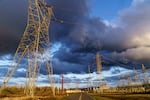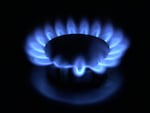Electric and gas rates are on the rise, and it’s being felt by Oregonians across the state.
Energy rates are going up, in part, due to the increase in the price of natural gas — predominantly methane gas— used to power homes and buildings. The transition from fossil fuels to renewable energy infrastructure, like wind, solar farms and battery storage is also a factor. And then there’s company profits.
Now, there is a push to put limits on how much an electric or gas utility can raise energy rates in one year, which could help energy bill shocks and prevent utilities from huge increases every year.
Last month, Oregon Citizens’ Utility Board proposed a rate cap on increases that would limit utilities’ energy rates to no more than 10% or 7% plus inflation, whichever is the lowest. Another nonprofit that supports rate caps, Earthjustice, says there are lessons to learn from limits imposed in Hawai’i.
To achieve these goals, advocates will likely need the support of the Oregon Public Utility Commission, the agency that regulates power and natural gas companies in the state.
A tipping point: As utility rates rise, customers feel a pinch
“I think we’re really reaching a tipping point with a lot of people’s budgets,” Oregon CUB’s outreach and communications director Charlotte Shuff said. “It’s definitely time for something to change.”
Some customers are paying nearly 50% more on their monthly energy bills than they did in 2019, according to Oregon CUB, a nonprofit utility watchdog group created by voters in 1984. Many bills have climbed $20 or $30 per month. Portland General Electric and NW Natural have raised rates by more than 20% in the last few years. Gas utility bills from Avista Utilities are up 31% since 2020, and Cascade Natural Gas energy bills are up 59% since 2020.

Electricity transmission towers, in Troutdale, Oregon, March 6, 2023. Across Oregon, many power companies are seeking rate hikes. A consumer advocacy group wants to cap how much the state's energy and natural gas providers can raise rates each year.
Kristyna Wentz-Graff / OPB
Customers could see rates rise even more in 2025.
Portland General Electric is seeking a 7.4% rate hike next year. NW Natural is asking to raise its customer’s gas rates by 18%. If that rate increase is approved by the Oregon Public Utility Commission, NW Natural customers’ average bill will be more than 50% higher than they paid in 2020.
Those increases are forcing some households to make difficult decisions, Anahí Segovia Rodriguez said. She is the energy justice coordinator at Verde, a nonprofit environmental justice organization. She’s heard people are struggling to pay for groceries, rides to the doctor or having to choose to pay for their internet connection for their kids to do their homework at home.

Anahí Segovia Rodriguez, energy justice coordinator for Verde.
Courtesy of Verde
She’s even heard of a family choosing to pay their energy bills over purchasing medication.
“The sacrifices we have to make to keep the lights on, they are starting to get a little more and more and more out of hand,” she said.
Segovia Rodriguez struggles herself.
She lives with her parents and despite having a three-income household, her energy bills are still high even after being more conscious of their energy use. She said she turns off unnecessary lights and has even set limits on using the heater.
“We’re still seeing such a big bill,” she said. “We’re doing everything right, you know, make sure that the lights are off when you’re leaving the room and our bill is still over $200 a month. That’s insane to us.”
Rate increases make it hard for people who are already on tight budgets, she said, especially since wages haven’t increased the same way as utility bills have and inflation has hurt many people’s budgets.
The rise in energy bills has led Verde, along with a coalition of climate, environmental, social justice organizations and the Oregon Citizens’ Utility Board, to call on the Oregon Public Utility Commissions to reject NW Natural’s current rate increase proposal.
“We’re trying to be an advocate for fair and reasonable rates and it’s important to us that the voices of everyday people are heard,” Segovia Rodriguez said.
The push to limit rate hikes
Oregon CUB’s Charlotte Shuff said her organization wants to reset expectations for both utilities and customers of what they can expect to see on bill increases.

Charlotte Shuff, Oregon Citizens’ Utility Board's outreach and communications director.
Courtesy of Charlotte Shuff
“We’re proposing a structure similar to what we saw the state legislature passed for rent increases,” she said. “We’re trying to make sure that customers are not facing down close to 20% increases every year. We know that’s not sustainable and frankly, we don’t think that utilities should be able to ask for that.”
According to Shuff, the proposal would require utilities to prioritize their commodity costs first. That could include purchasing fuels, like methane. Natural gas utilities move methane into customers’ homes to be burned in furnaces and stoves. Electric utilities use natural gas as fuel to generate electricity, which they burn in power plants. If the proposed 10% rate cap is enough to cover those commodity costs, utilities then could spend any remaining revenue they get from rates on infrastructure upgrades and company profits.
If the cost of doing business requires more than what the 10% rate hike would cover, the utilities would have to spread those additional costs out over future years, in order to keep the annual customer bill increase to no more than 10%.
“The goal is for this to be used as rarely as possible,” Shuff said. “There shouldn’t be a situation super often where utilities are asking for more than 10% bill increases from customers.”

A blue flame burns on a natural gas stove. The price of natural gas, primarily composed of methane, affects the price of electricity.
Cassandra Profita / OPB
OPB reached out to Oregon’s largest utilities — Idaho Power, NW Natural, Portland General Electric and Pacific Power — seeking comments on the Oregon CUB’s proposal.
A spokesperson with PGE said the utility will continue to be “fully engaged” in the rate review process and will address the proposed rate cap increase when it’s presented to the utility.
Pacific Power said it had not received or reviewed any CUB proposals related to its own rates and noted that it seeks to keep rates low, but must make investments in the grid and respond to wildfire risks.
NW Natural officials did not provide comments regarding Oregon CUB’s proposed rate cap increase.
Instead officials focused on their lower-income programs and on the broader historical rate trends going back more than a decade.
A spokesperson for Idaho Power acknowledged that the utility is in conversations with Oregon CUB but declined to comment on the rate cap increase proposal.
For now, the Citizens Utility Board is seeking to cap rate increases on a case-by-case basis. It’s using the state Public Utility Commission’s rate review process to advocate each time a power or natural gas company asks for a hike.
“We believe that this is something that the [utility] commission could implement themselves. That is definitely going to be a big debate,” Shuff said. “This is something that we haven’t suggested before. So, we understand that we’re in new territory on this.”
The Oregon Public Utility Commission and utilities also have other tools to lower high energy bills for customers, Shuff said. They can delay rate increases until spring or summer, so customers don’t see rates rise during winter months when gas and electric use are usually the highest. The state could also lower utility profits.
So far, Oregon CUB’s proposal on capping rate increases has been presented to Idaho Power and NW Natural through the state utility commission’s process. The Citizens Utility Board plans to propose the same approach to limit Portland General Electric and Pacific Power’s upcoming rate proposals in the coming months.
Shuff said Oregon CUB hopes the Public Utility Commission will apply the rate cap to all for-profit utilities in the state. But it’s possible the commission could opt to limit rates at one utility instead of across the board.
The Hawai’i approach: A limit on utility revenue

Jaimini Parekh, senior attorney for Earthjustice.
Courtesy of Earthjustice
Earthjustice, a national nonprofit public interest law organization, supports caps on rate increases. Staff there note that there are multiple approaches to limiting how much electric and natural gas bills climb.
It successfully advocated for something similar in Hawai’i in 2020, senior attorney Jaimini Parekh said. Instead of rate caps on increases, Earthjustice advocated for revenue caps to limit utility spending.
“What that means is, it says, ‘Utility company, you’re only allowed to receive a certain amount of revenue from customers and this revenue will be effective for a certain period of time and that might be a few years,” she said.
Under the “performance-based regulation” model, a utility must provide its customers good service to earn a profit, Parekh said. That helps align financial incentives with customer needs and state policy goals.
A focus on the most vulnerable rate-payers
But with or without the proposed rate caps, there is a growing effort to alleviate energy bills for low-income households.
Earthjustice provided recommendations to the commission that include increasing NW Natural’s spending on weatherization and electrification programs. Like switching to energy efficient appliances to help the transition away from fossil fuels. They are also calling for deeper discounts for low-income households, Parekh said.
“What we’re really trying to do in this case is both reduce and eliminate continued spending on fossil fuel infrastructure, which is going to harm us in the long term when it comes to responding to and addressing climate change, which is already having major impacts on Oregonians,” she said. “Also ensuring that low-income Oregonians are able to actually afford basic utility services.”
There are also calls to expand utility programs that help people with their bills by redefining who qualifies as low-income, Verde’s Segovia Rodriguez said. She said there are many households that make just enough money to disqualify them from receiving low-income assistance, and those families “are still struggling day to day”.
“Every time we raise the rates, these are the families that are being impacted because they just don’t fit under those programs,” she said.
The utilities’ perspective

Mary Moerlins, NW Natural’s director of environmental policy and corporate responsibility.
Courtesy of NW Natural
According to NW Natural, customers are paying $6 less than they did 15 years ago. In 2009, customers were paying about $86 a month. Now, customers are paying $80.
“Rates have increased internationally the last few years and customers have seen the prices of many everyday goods and services go up,” NW Natural’s director of communications David Roy said. “Commodity prices also went up following Russia’s invasion of Ukraine.”
To help balance those costs, the gas utility offers several bill discount programs for qualified low-income households, Mary Moerlins said. She’s NW Natural’s director of environmental policy and corporate responsibility. The utility also offers the Oregon Low-income Energy Efficiency program that works with community action organizations that provide qualified households with services like insulation and high energy efficient appliances.
“We are working to make multiple pathways to affordability available for customers,” Moerlins said.
So far 6% of the utility’s customers are enrolled in the low-income qualifying rate program, she said.
Next steps for advocates of rate limits
Segovia Rodriguez advocates for the Oregon Public Utilities Commission and the state’s gas and electric utilities to move away from a “numbers perspective” and start to look at things from a holistic point of view.
“There’s more to energy than just money and numbers and that there’s people whose everyday lives are being impacted,” she said.
That focus on people is behind the push to limit rate increases and make electricity more affordable.
General rate cases usually go through a lengthy year-long process that includes intervenors like Oregon CUB, Verde and Earthjustice to submit testimony. It also involves closed-door negotiations with intervenors to reach a settlement and a final OPUC decision on rate increases before the end of the year.


